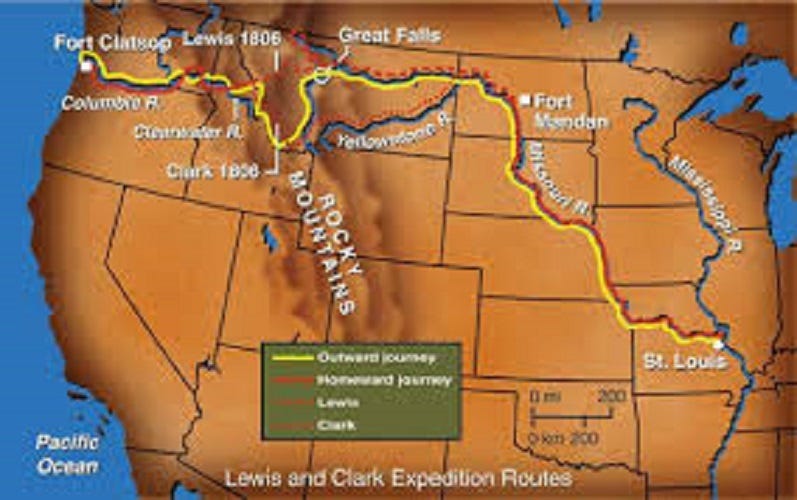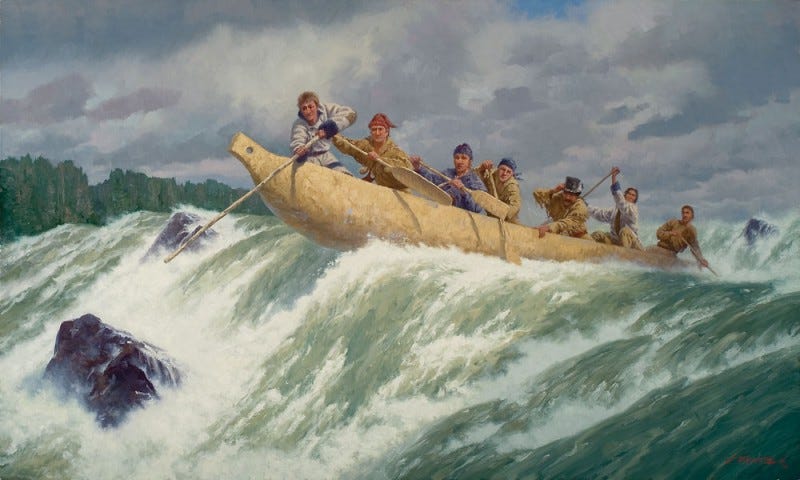Meriwether Lewis (1774-1809), William Clark (1770-1838) and their crew spent three hard winters and three Christmases away from civilization: 1) Camp River Dubois at the mouth of the Missouri River; 2) Ft. Mandan near present-day Bismarck, North Dakota and 3) Ft. Clatsop near present-day Astoria, Oregon.
CAMP RIVER DUBOIS: 1803
The expedition was not far from civilization (22 miles north of St. Louis, population 1,000 - 1,400) when they built Camp River Dubois on the east side of the Mississippi River at its confluence with the Missouri River. The Missouri would be their river route during the first leg of their journey. They arrived on December 12, 1803 in wind, hail and snow. They quickly began making a camp of log buildings. By January the temperatures would reach 10 degrees below freezing. The party spent five months at Camp River Dubois making final preparations for their long journey up the Missouri River.
On December 25th, the men awoke Clark with a round of gunfire, a Southern tradition. Their Christmas feast included deer, turkey, cheese and fresh butter. That day brought snow, with ice running in the river, and the men celebrated by firing their rifles, carousing, and hunting; some got drunk and two fought.
FORT MANDAN: 1804
The Corps of Discovery followed the Missouri River north, choosing as their second winter camp a place near the Mandan Indian Villages, not far from present-day Bismarck, North Dakota. On November 2, 1804 the men began building a two-winged, stockaded fort of cottonwoods logs. In his journal, Sergeant John Ordway noted that “our huts” were “4 Rooms 14 Feet Square” on each of two walls. Even though the fort was unfinished, the men moved into it two weeks later, when the weather turned colder.
As they were building their quarters Toussaint Charbonneau (1767-1843), a French-Canadian trader, approached Clark. On November 4th, Clark recorded the encounter in his journal: “a French man by Name Chabonah, who Speaks the Big Belly language visit us, he wished to hire & informed us his 2 Squars were Snake Indians, we engau him to go on with us and take one of his wives to interpet the Snake language.” Thus, Lewis and Clark met Sacagawea (1788-1812) who would prove to be an invaluable addition to their crew.
Christmas Day began with three volleys of the men’s rifles awakening Captains Lewis and Clark before dawn. Captain Clark recorded in his journal: “I was awakened before Day by a discharge of 3 platoons from the Party and french, the men merily Disposed, I gave them all a little Taffia* and permited 3 Cannon fired, at the raising Our flag, Some Men Went out to hunt & the others to Dancing and Continued untill 9oClock P. M. when the frolick ended.”
The journals do not reveal what the men ate for their Christmas Dinner; however, it was certain one of the dishes was corn obtained from the Mandan Indians who were farmers. The men may have had some buffalo meat remaining from their December 7th hunt.
FORT CLATSOP: 1805
The Corps of Discovery thought they spotted the Pacific Ocean on November 7, 1805. Captain William Clark wrote in his journal: “Ocian in view! O! the joy.” Then he added “Ocian 4142 Miles from the Mouth of Missouri R.” In reality, they had spotted the Columbia River’s broad estuary. No matter, as they knew they had reached the last leg of their westward journey.
Clark and part of the crew (11 men) reached the actual Pacific Coastline, on present-day Long Beach Peninsula, Washington, on November 18th. This was after eleven days of abject misery on the northern side of the Columbia River’s very wide mouth near present day Ilwaco, WA: “we are all wet and disagreeable.” Besides personal comforts, they needed to locate a good hunting ground near their winter camp, as well as a place to extract salt from sea water, and timber with which to build their winter quarters.
The Clatsop Indians assured them that elk were plentiful on the southern side of the Columbia River. Therefore, after a vote of every crew member, they crossed the river and arrived just south of present-day Astoria, Oregon, where they built Ft. Clatsop. On December 8th, the men began clearing land for Fort Clatsop. They felled trees, split logs for boards, raised buildings, and chinked log walls until Christmas Eve, when most of the men moved into their “huts.”
On December 25, 1805, Clark wrote in his journal: “at day light this morning we were awoke by the discharge of the fire arm of all our party & a Selute, Shoute and a Song which the whole party joined in under our windows, after which they retired to their rooms were Chearfull all the morning.”
“The Captains divided out the last of their tobacco among the men that used and the rest they gave each a Silk hankerchief, as a Christmast gift . . . .” wrote Sergeant John Ordway in his journal. Captain Clark wrote “I recved a presnt of Capt L. of a fleece hosrie Shirt Draws and Socks—, a pr. mockersons of Whitehouse, a Small Indian basket of Gutherich, two Dozen white weazils tails of the Indian woman . . . .”
The Christmas at Ft. Clatsop was a poor one. The men exchanged small personal presents before they ate spoiled elk, spoiled fish: “We would have Spent this day the nativity of Christ in feasting,” Clark journaled, “had we any thing either to raise our Sperits or even gratify our appetites. Our Diner concisted of pore Elk, So much Spoiled that we eate it thro’ mear necessity. Some Spoiled pounded fish and a fiew roots.” He emphasized, “a bad Christmass diner.”
On Christmas Day, 1805, Private Joseph Whitehouse wrote in his journal, thanking God for their survival.“We had no ardent spirit of any kind among us; but are mostly in good health, A blessing, which we esteem more, than all the luxuries this life can afford, and the party are all thankful to the Supreme Being, for his goodness towards us.— hoping he will preserve us in the same, & enable us to return to the United States again in safety.”






